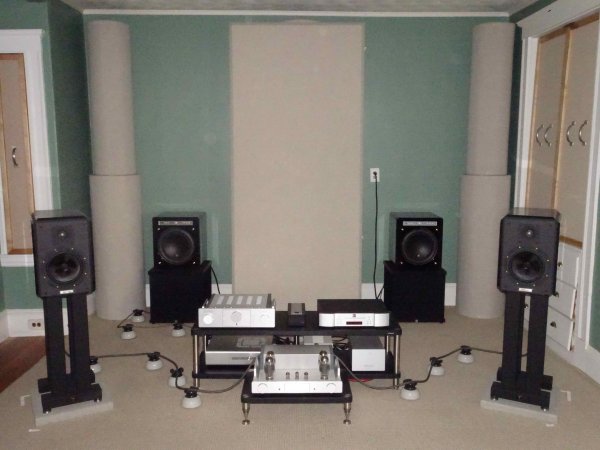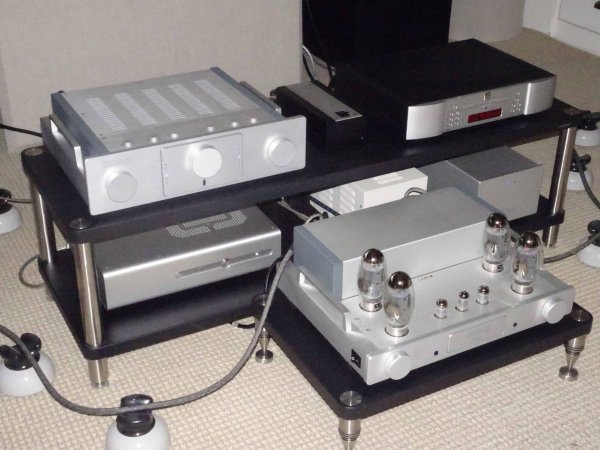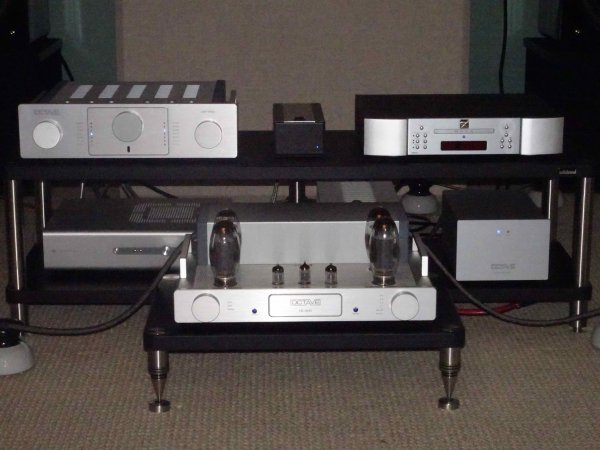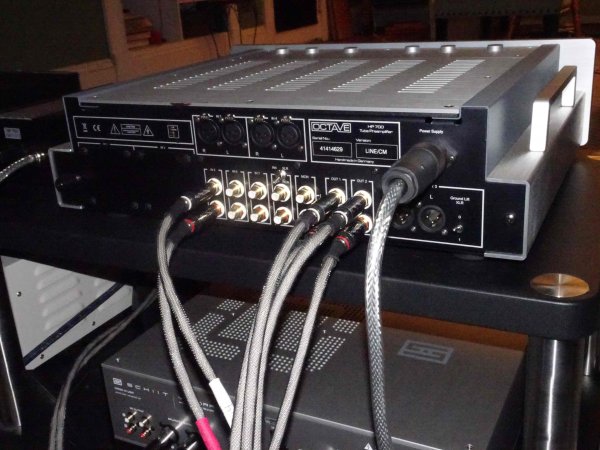Octave Audio website:
http://www.octave.de/en/
Info on the HP 700:
http://www.octave.de/en/htdocs/verstaerker/hp700.php
Price of the Octave HP 700 preamp w/o control module, $ 12,500; with control module, $ 15,200; phono input modules optional
Background
The Pass B1 JFET buffered preamp (no gain) had been in my system for a while. Due to its low output impedance it is nominally able to drive both my amp and the subwoofers, and I had thought it did so fine. My friend Ian (Madfloyd), also from experience in his own system, had the impression that the Pass B1 introduced a slight metallic coloration into the sound on some material – he would be proven right. Thankfully, earlier this year he suggested that we should try what happens with his darTZeel active gain preamp in the system, and he brought it along. This was a brilliant move and an eye opener.
I had always thought that some residual strain on orchestral music was a limitation of the Reference 3A Reflector two-way monitors (supplemented with JL Audio Fathom 112v2 subwoofers run in parallel, without crossover). Yet it turned out that, with the darTZeel preamp in the chain, in my mid-sized room the monitor/sub system could, at a quite loud level (peaks at or slightly above 100 dB), reproduce orchestral music cleanly and effortlessly! This was incredibly welcome news since in general I loved these highly resolving monitor speakers, and this just completed the picture. There was also yet another increase in resolution with this high-quality preamp.
All things just came together nicely at that moment: I would not have been able to sufficiently appreciate the alleviation of strain with the high-quality active preamplifier, had I not a few weeks earlier installed my ASC custom ceiling diffusers (
see pictures and report on my system thread) that removed a lot of room distortions, rounding off extensive room treatment that I had embarked on over the years.
So I started to think about options for an active gain preamp. There were alternatives to consider, such as TVC preamps, but there is a lack of opportunity to audition such and other no-gain designs prior to purchase. Furthermore, I already knew that my system reacted positively to the insertion of a high-quality active gain preamp.
Given that I already have an Octave RE 320 amp, a synergistic approach suggested an Octave preamp. Since Goodwin’s High End, my trusted dealer for many years, had the Octave HP 300 SE in the store (I also bought the Octave RE 320 amp from them), I decided to try it in order to get acquainted with the common sonic flavor of the Octave preamps. This would allow me to make a more informed decision about the HP 700 preamp that I had in mind, which is the natural partner for the RE 320 amp and has a tone control option that I wanted (the optional control module also includes balance control). Alan Goodwin generously gave me the opportunity to try out at home the HP 300 SE over two weekends, and I loved it. Hearing it on the second occasion thankfully helped me avoid a mistake in a DAC selection, as the Octave preamp allowed me to hear a synthetic coloration that the Pass B1 buffer masked; eventually I went for the current Yggdrasil Analog 2 upgrade since this DAC has a superior tone.
Fruitful phone conversations and email exchanges, facilitated by Alan Goodwin and involving Mike Manousselis from Dynaudio, the US importer of Octave, as well as Andreas Hofmann, the designer of Octave, addressed sonic and technical questions. Mike forwarded my technical questions to Andreas Hofmann who graciously answered them in detail and with whom later I also had direct email contact.
After all these great experiences I decided to go for the Octave HP 700. The HP 300 SE is excellent, but the HP 700 is even better. I could not be happier with my acquisition. The effortlessness on orchestral music that I first heard with Ian’s darTZeel preamp is all there as well.
Tonality and resolution of timbral detail
What struck me with the Octave HP 300 SE was the great tone, in particular on hard to reproduce timbres. The sound as a result of both the vibration of the strings and the resonances of the wooden body of violins, viola and cello in string quartets is portrayed in a convincingly natural way. On the best solo violin recordings, there is a beautifully wooden tone in lower and middle register, and silvery but really sweet and delicate tone (when the music allows) in the high register. Woodwinds sound sublime. Orchestral massed violins sound great too.
The HP 700 expands on all this with yet greater finesse, which also allows for even more subtlety of orchestral string tone, enhancing the realism. The delicate micro-detail on string quartet timbre is just stunning, I have not heard better elsewhere. Neither have I heard better tone on string quartets, other than in live performances, the sound of which is approximated to a degree that I had not thought possible from a system a few years ago.
The HP 700 (like the HP 300 SE) does not inject any obvious ‘tube warmth’ into the music and it does not thicken textures (neither does it thin them out). Rather, it does something far more meaningful, and important: it allows for an impressive depth of tonal color to be transmitted, which comes closer to the real thing. There is a rich shading and differentiation of color. Yet the differences between recordings are just as great as before. Piano is heard with a fully ‘wooden’ tone on some recordings, and on other recordings still with, now even better differentiated, metallic overtones. Warm sounding recordings with a generous lower midrange retain their warmth, but the thin iciness of the sound of, for example, the recording of Ferneyhough string quartets with the Arditti Quartet (in an excellent performance) is still there, even though also here the sound is more colorful, less bleached. Brass color between diverse recordings of a given Bruckner symphony keeps varying considerably, as before, yet is richer. On the other hand, an external addition of color would likely lead to homogenization of sound between recordings, which is not the case. Rather, it seems that the Octave HP 700 preamp better manages to preserve the original depth of color in the music, prevents it from being flattened and thus allows for a more realistic presentation of the music.
The rich tonality emerges from a quiet background. On many large scale orchestral recordings there is, with this preamp in the chain, an authoritative, spacious calmness in the sound field out of which events emerge, and if asked for, explode in a firm, incisive manner.
The preamp’s prowess with depth of color also serves early digital recordings on CD well. The 1982 digital recording (Decca) of the outstanding performance of Mahler’s Ninth Symphony by the Chicago Symphony under the direction of Solti, while featuring an impressively wide dynamic range, had always sounded somewhat thin and bleached out on my system, to the point of annoyance. When the preamp was not yet broken in I found that I preferred the reproduction with the tone control activated and the treble about 3 dB down. Yet now the recording sounds great to me as is. There is, again, a depth of color that was not there before, in any of the previous iterations of my system, and while the tonal balance is still rather light (yet not outside of what is experienced in the acoustics of some concert venues), the sound is not obviously thin as it was before. The extremely resolved string texture is sublime, other instruments also have a convincing tone, and everything sounds marvelously differentiated. Why should I dull this transparency by lowering the treble output?
After the success with Mahler 9 I turned to another early digital recording that previously had sounded problematic, to say the least. It is the 1986 recording on CD of orchestral pieces by Berg, Webern and Schoenberg with the Berlin Philhamonic / James Levine (DGG). In the past it had, with a previous digital front end in the chain as well, at certain moments sounded shrill and congested. Now the dissonant, high registered violins, woodwinds and trumpets in the climax of the first of Schoenberg’s Five Pieces for Orchestra do not congeal and continue to sound open. In fact, the sound here and overall on this recording is spectacular, again with an enormous amount of shading and depth of color. Just like with the Mahler 9 recording there is also this authoritative, spacious calmness in the sound field out of which the music arises. Nothing suggests the nervous brittleness associated with early digital sound, and experienced on these recordings in my system before I had the current digital front end and Octave HP 700 preamp in the chain.
All in all, so far I have not found it necessary to use the treble control of the preamp that I thought I might need; the tone control can be bypassed for neutral mode. For bass adjustments I use the volume control on the subwoofers which, given that I integrate them with monitors, not just influences the level of the low bass. Yet also here the frequency of adjustments has decreased drastically with the more recent improvements in bass performance of the system, including the ones provided by the new preamp (see below). However, for some recordings the ability to adjust bass via subwoofer volume still remains highly welcome – the amount of bass simply varies too much at times between recordings. I’ll save the treble control of the preamp for some nasty sounding pop recordings that eventually I may spin at some point. For several recordings I do very much need the frequency compensated balance control in the preamp’s control module (which includes the tone control).
(cont.)























